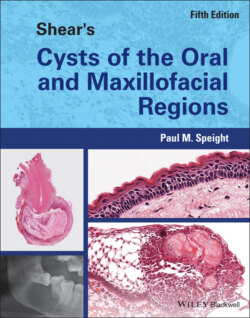Читать книгу Shear's Cysts of the Oral and Maxillofacial Regions - Paul M. Speight - Страница 70
Radiological Features
ОглавлениеThe clinical features of inflammatory collateral cysts are not specific and an accurate diagnosis can only be made after consideration of the radiological features, which are characteristic (Box 4.2).
The paradental cyst shows a number of quite specific but subtle features, which were first described by Craig (1976 ). On conventional radiographs the cyst presents as a well‐demarcated radiolucency, usually with a corticated margin. This is well illustrated in Figure 4.2, which shows radiographs from the paper by Vedtofte and Praetorius (1989 ). Of note is that the case illustrated in Figure 4.2a is of bilateral paradental cysts associated with second molars, in a 13‐year‐old girl where the third molars are absent. The cyst is usually displaced distally, but in all cases the radiolucency is superimposed over the buccal aspect of the tooth and overlies the roots and bifurcation area. Most paradental cysts are 10–15 mm in diameter (Philipsen et al. 2004 ) and rarely exceed 20 mm. Larger lesions may appear to be periapical, but it is important to note that the periodontal ligament space is not widened and the lamina dura is intact around the roots (Figures 4.2 and 4.3). Most cysts extend distally, but the distal element is well defined and is distinct from the distal follicular space (Figure 4.2). This feature was first noted by Craig (1976 ) and was confirmed by Colgan et al. (2002 ), who identified it in 9 of their 15 cases and considered it to be an important and helpful diagnostic criterion, since it indicates that the dental follicle is not involved in the development of the cyst.
